Insectivorous birds, also known as avian insectivores, play a key role in keeping our ecosystems balanced. They act as natural pest controllers. These birds are found in many places, from the Americas to Asia and Australia.
They have different ways of hunting and adapting to their environments. This makes them very interesting to study.
These birds are the quiet heroes of nature. They keep insect numbers in check without making a fuss. By welcoming them into your garden or local area, you help control pests.
You also get to see the beauty of their diversity. Explore the world of insectivorous birds. See how they help make our environment healthier and more balanced.
Introduction to Insectivorous Birds
Insectivorous birds are fascinating creatures that mainly eat insects and small invertebrates. These insect-eating birds are crucial for keeping ecosystems in balance. They are known as entomophagous birds or insectivorous avifauna.
What are Insectivorous Birds?
Insectivorous birds are expert hunters. They catch and eat many insects like beetles and caterpillars. They have special beaks and tongues to help them find and eat insects.
Significance in Pest Control
Insectivorous birds are very important for controlling pests. They eat harmful insects, protecting plants and the environment. They eat a huge amount of insects every year, helping ecosystems thrive.
But, many insectivorous bird species are declining fast. Some areas have seen their numbers drop by up to 50% in 20 years. This decline is linked to a bigger problem: fewer insects overall.
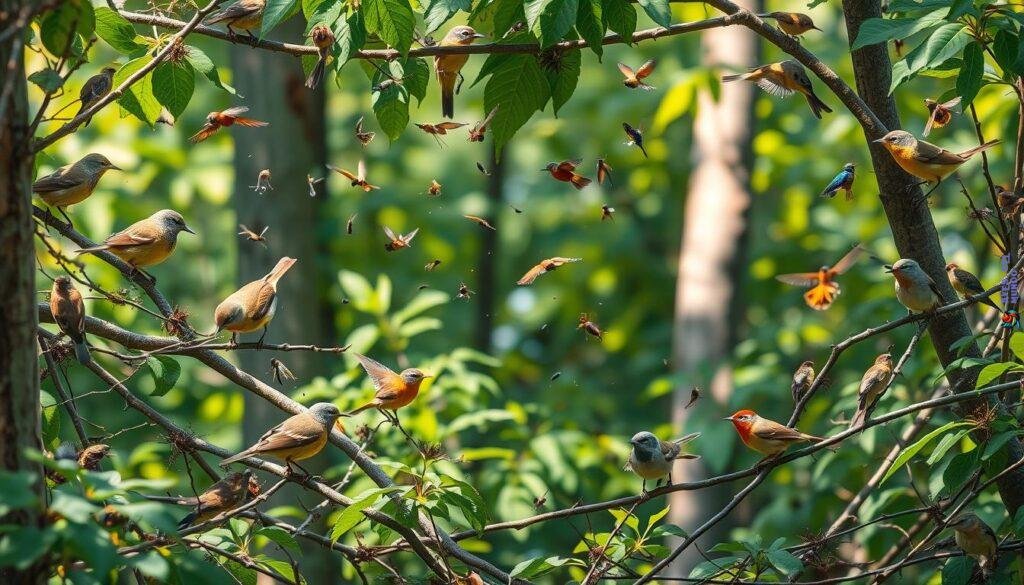
We need to understand and tackle these environmental issues. The role of insectivorous birds in controlling pests will grow more important. This highlights the need to protect these amazing birds for our planet’s future.
Diversity of Insectivorous Birds
The world of insectivorous birds is vast and fascinating. It has a wide range of species across different orders. These birds show various physical traits, hunting methods, and adaptations. This diversity helps them thrive in different habitats and play key roles in their ecosystems.
From tiny hummingbirds to powerful raptors, the insectivorous bird species are amazing. They include passerines like flycatchers and warblers. Even some waterfowl eat aquatic invertebrates.
In Yasuní National Park, over 500 bird species have been found, many being insectivores. Sadly, their numbers are declining. In Ecuador, bird populations have dropped by nearly 50% since 2001. In the U.S. and Canada, breeding bird numbers fell by 29% in 2019.
| Species | Region | Population Trend |
|---|---|---|
| Mist-net birds in Soberanía National Park, Panama | Panama | Widespread declines, with 35 species showing declines of more than 50% from 1977 to 2020 |
| Ground-dwelling insect-eating birds in Brazil | Brazil | Significant population declines when resurveyed in the 2010s compared to the 1980s |
| Great Tit (Parus major) | Europe and Asia | Stable and increasing population in many regions, including the UK |
Despite worrying trends, the diversity of insectivorous bird species shows nature’s strength. These birds are vital for ecosystem balance. Preserving their diversity is key for our environments and the planet’s health.
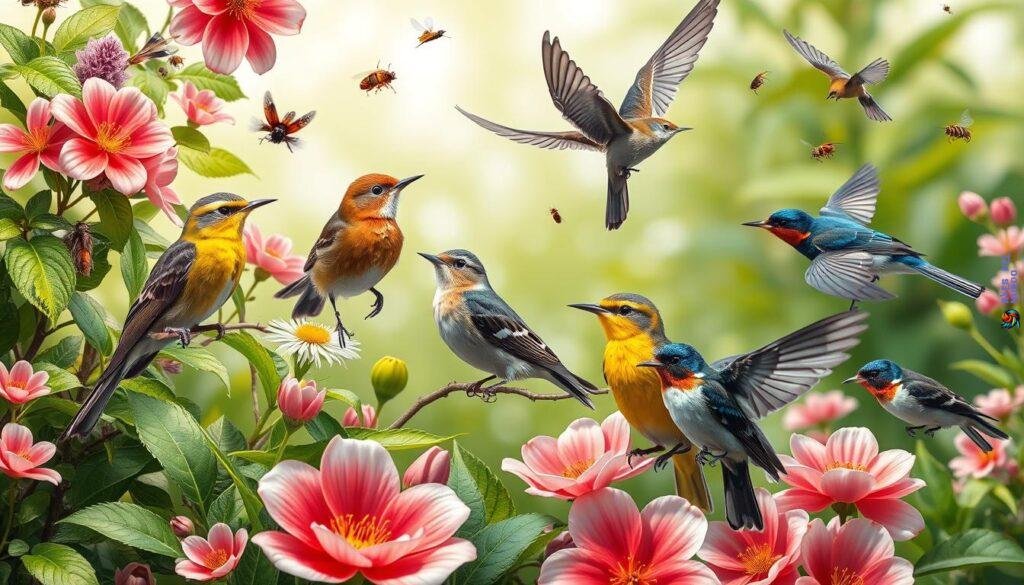
Insect-Hunting Strategies
Insectivorous birds have developed many ways to catch insects. They range from flying acrobats to careful foragers. These birds show the amazing variety of ways to hunt insects in nature.
Aerial Hunters
Flycatchers and swallows are top aerial insect predators. They are great at catching insects in mid-air. They use their sharp eyes and quick reflexes to grab insects right out of the sky.
Flycatchers wait on a high spot to jump at insects. Swallows, on the other hand, show off their flying skills with fancy moves to catch insects.
Foliage Gleaners
Foliage-gleaning insectivores like warblers and titmice pick insects from leaves and branches. They carefully look through the foliage to find caterpillars, aphids, and other small insects. Their sharp bills help them get insects that others can’t reach.
These birds are good at moving on thin twigs. This lets them find insects in places other birds can’t get to.
Bark Foragers
Bark-foraging insectivorous birds like nuthatches and woodpeckers use their bills to get insects from tree bark. They climb trees and search for insects hiding in the bark. Their special bills and movements help them find insects that others miss.
The different insectivorous avian hunting techniques show how these birds have adapted to their environments. By hunting in different ways, they help keep insect populations balanced in their habitats.
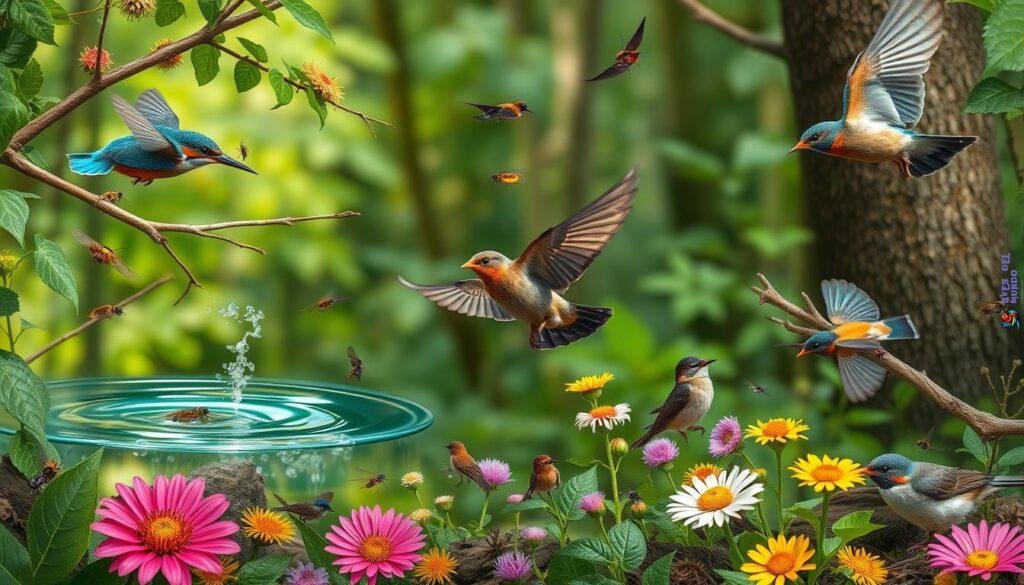
Unique Adaptations for Insect Eating
Insectivorous birds have amazing physical features for hunting insects. They have special beaks and tongues for catching and eating insects. The shapes and sizes of their bills and tongues help them find food in different places.
Specialized Beaks and Tongues
These birds have different beak shapes and sizes for eating insects. Flycatchers and swallows have wide, flat beaks for catching insects in the air. Woodpeckers and nuthatches have strong, pointed beaks for finding insects in bark and crevices.
They also have unique tongues. Many birds have long, sticky tongues to catch and hold insects. Hummingbirds have long, thin tongues to reach deep into flowers for nectar and insects.
| Beak Adaptation | Feeding Strategy | Examples |
|---|---|---|
| Wide, flat beak | Aerial insect hunting | Flycatchers, Swallows |
| Strong, pointed beak | Probing crevices and bark | Woodpeckers, Nuthatches |
| Long, sticky tongue | Capturing and holding small insects | Many insectivorous species |
| Long, slender tongue | Nectar and insect extraction | Hummingbirds |
These special features help insectivorous birds find and eat many types of insects. They play a key role in keeping ecosystems balanced.
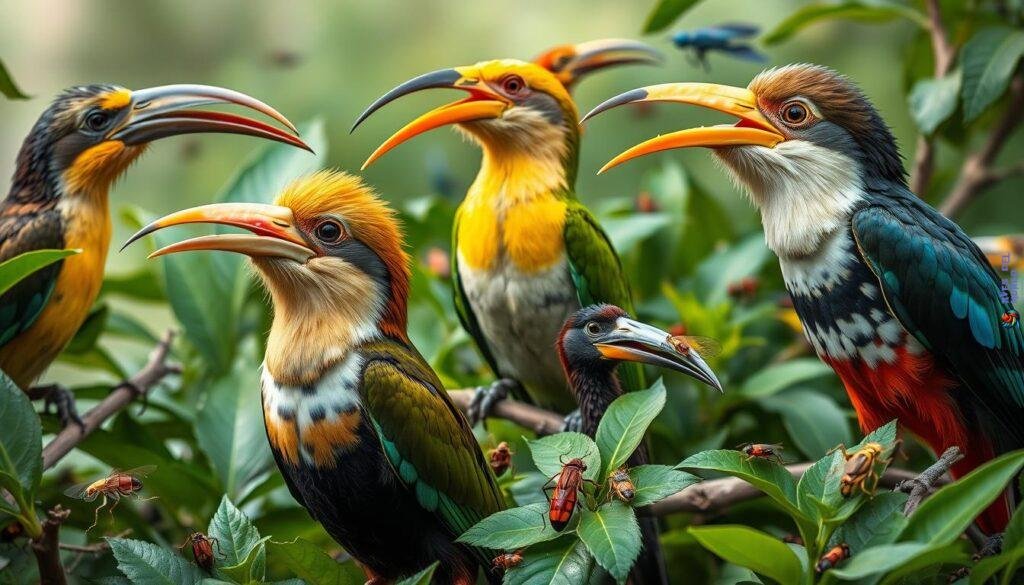
Ecological Importance of Insectivorous Birds
Insectivorous birds are key to keeping ecosystems in balance. They control insect numbers, which stops pests from harming plants and crops. These birds are natural pest controllers, helping environments stay healthy and productive.
They support the web of life that keeps ecosystems thriving. This is crucial for the health of our natural world.
Maintaining Ecosystem Balance
The role of insectivorous avifauna is vital. Almost all North American bird species feed insects to their young. Yet, their numbers have dropped by almost 3 billion in 50 years.
On the other hand, non-insectivorous birds have grown by over 26 million. This shows how important insectivorous birds’ ecological role is in keeping ecosystems balanced.
Birds eat a huge amount of insects every year. They play a key part in controlling insect numbers. With insects making up 80-90% of all animal species, birds are essential for ecosystem health.
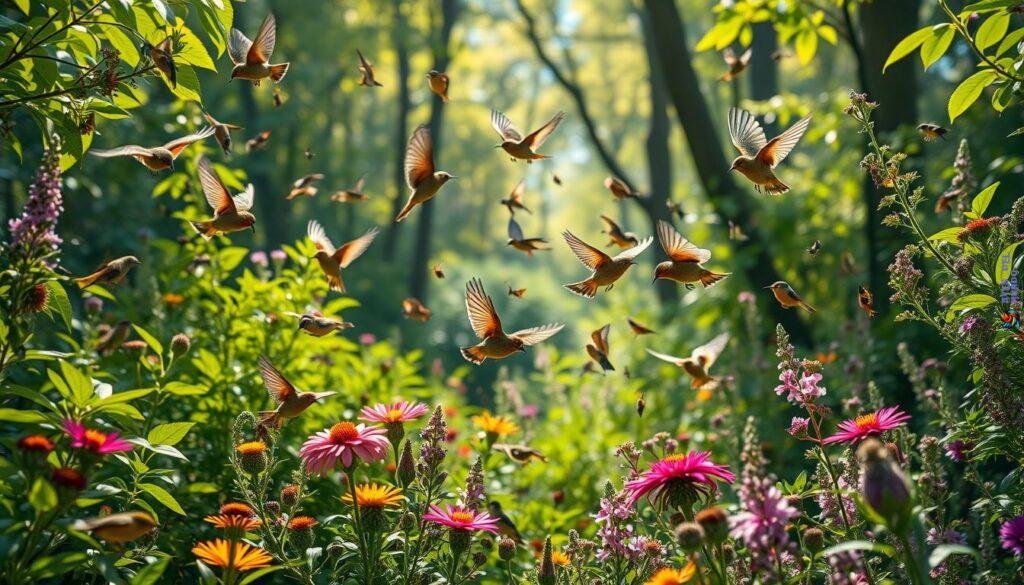
But, insect populations are declining. In Germany, natural areas have lost 75% of insects in 25 years. In Puerto Rico’s Loquillo rainforest, ground and leaf canopy insects have dropped by 98% and 80% respectively over 35-40 years.
This decline threatens the insectivorous birds’ ecological role and ecosystem balance.
Insectivorous Birds Around the World
Insectivorous birds are found all over the world. They feed on insects and small invertebrates. Each region has its own special birds, adapted to their environment and prey.
North American Insect-Eating Birds
In North America, birds like the Eastern Bluebird, Downy Woodpecker, and Eastern Phoebe are well-known. They help control insect numbers, keeping ecosystems balanced.
South American Insectivorous Avifauna
South America is home to many insect-eating birds. The Tyrannidae family of tyrant flycatchers is especially notable. These birds hunt insects, helping South American habitats stay healthy.
European Bug-Eating Birds
In Europe, birds like the Spotted Flycatcher and European Robin are insectivorous. Each is adapted to its environment and prey. They help keep insect numbers in check, ensuring a balanced ecosystem.
Asian Insect-Hunting Birds
Asia has a wide variety of insect-eating birds. The Asian Paradise Flycatcher and Oriental White-eye are examples. These birds are vital for controlling pests and maintaining habitat health.
Australian Insectivorous Avians
Australia’s insectivorous birds include the Rufous Fantail and Grey Fantail. These birds are key to the Australian ecosystem. They help regulate insect numbers and boost biodiversity.

Insectivorous birds are found everywhere, each region with its own special species. From the Eastern Bluebird in North America to the Rufous Fantail in Australia, they are crucial for ecosystem balance worldwide.
Insectivorous Birds
Insectivorous birds, also known as entomophagous birds, have special traits that help them catch insects. They have beaks, tongues, and flight skills that let them find and eat many insects. This makes them great at controlling insect numbers.
These birds have beaks and tongues made for catching insects. Their beaks are long and pointed, perfect for picking insects from leaves or the ground. Their tongues have special bristles or barbs to hold onto their prey.
- Insectivorous birds are very good at flying and catching insects in mid-air.
- They have sharp eyes and ears to find insects, even in dark places or thick plants.
- There are many types of insectivorous birds, each living in different places. This helps keep their ecosystems balanced.
By eating insects, these birds help keep pest numbers down. This is good for crops, forests, and cities. They are very important for keeping nature healthy.
| Insectivorous Bird Characteristics | Description |
|---|---|
| Specialized Beaks | Slender, pointed beaks well-suited for plucking insects from foliage, bark, or the ground |
| Unique Tongues | Tongues with bristles or barbs that assist in grasping and manipulating prey |
| Aerial Agility | Exceptional maneuverability that allows them to catch insects in flight |
| Keen Senses | Acute eyesight and sensitive hearing to detect and locate their prey |
| Ecological Diversity | Variety of species that exploit a wide range of ecological niches |
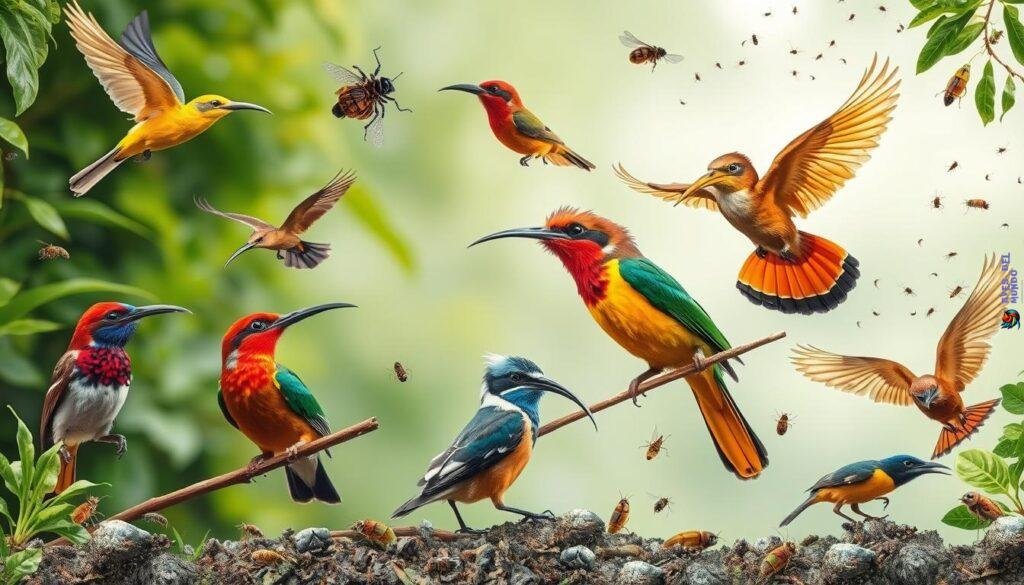
Attracting Insectivorous Birds to Gardens
Let’s tap into nature’s pest control experts – insectivorous birds! By making your garden welcoming, you can attract these helpful birds. They play a key role in keeping your garden healthy. Follow these steps to attract insectivorous birds and support their important work.
Begin by adding native plants that meet the needs of insect-eating birds. These plants offer insects, shelter, and breeding spots. Also, add a birdbath or small pond for water, a must for birds.
- Choose native plants that attract a variety of insects, which in turn draw in insectivorous birds.
- Install bird feeders specifically designed for insect-eating species, such as suet feeders or mealworm feeders.
- Provide suitable nesting sites by installing birdhouses or leaving areas of your garden undisturbed for natural cavities and vegetation.
By making your garden insectivorous bird-friendly, you’ll enjoy their company and help your garden’s health. These birds eat pests, reducing the need for harmful chemicals. Enjoy gardening for insect-eating birds and see your garden thrive without pests.
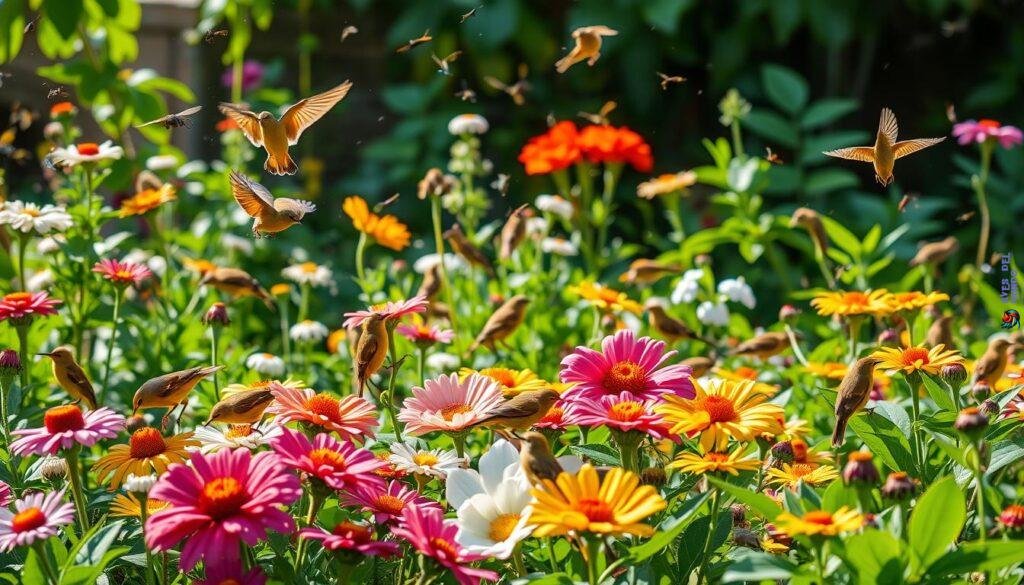
Conservation Challenges and Efforts
Insectivorous birds are key to keeping our ecosystems balanced. But, they face many challenges. Habitat loss, pesticide use, and climate change are big threats. To save these birds, we need to restore habitats, cut down on pesticide application, and educate the public.
Habitat loss is a big problem. As cities and farms grow, natural areas where insectivorous birds live are disappearing. This makes it hard for them to find food and places to nest, leading to fewer birds.
Pesticides are another big danger. They can harm insectivorous birds by making the insects they eat poisonous. To help these birds, we should support farming that uses fewer pesticides.
Climate change is also a threat. It can mess up the timing of when insects appear, making it hard for birds to find food. We need to keep watching and adapting to help these birds.
But, there are many efforts to save insectivorous birds. Projects are working to make better homes for them. And, campaigns are teaching people why these birds are important.

By working together, we can beat the challenges and keep these birds safe. This way, they can keep helping our ecosystems for years to come.
Insectivorous Birds as Bioindicators
Insectivorous birds are key indicators of environmental health. They feed on insects and show us how well an ecosystem is doing. These birds are very sensitive to changes in their environment.
They help us understand the impact of human activities on nature. Their numbers and types tell us a lot about the health of their habitats.
The Yellow Warbler is a great example. It lives in North America and eats insects like caterpillars and beetles. This helps plants grow by controlling pests.
Yellow Warblers are easy to spot because of their unique song. They can live up to 10 years in the wild. Their size is about 4.7 to 5.1 inches, with a wingspan of 6.3 to 8.7 inches.
Their presence or absence can signal changes in the environment. This can lead to conservation efforts. For example, studies have used birds like Yellow Warblers to check on wetlands and pollution levels.
By watching these birds, we learn a lot about ecosystems. We can see how human actions affect nature. This helps us make better choices to protect our environment.
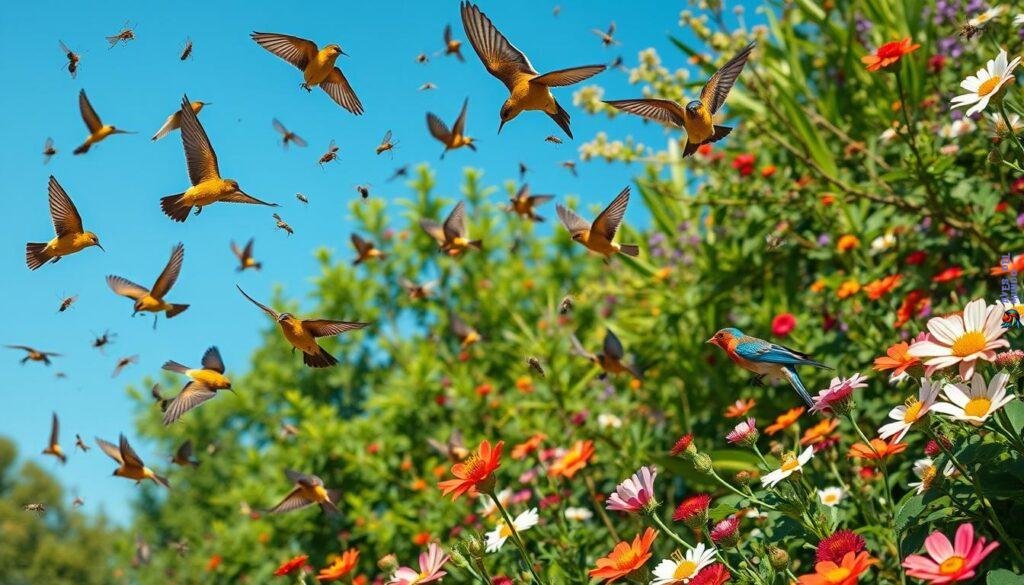
In conclusion, insectivorous birds are important indicators of our environment’s health. They help us understand and protect our ecosystems. By paying attention to them, we can keep our natural world healthy and resilient.
Fascinating Facts About Insectivorous Birds
Insectivorous birds are amazing creatures. They mainly eat insects and have special ways to hunt and adapt. These birds give us a peek into the natural world’s intricate connections.
One cool thing about these birds is their amazing flying skills. Aerial hunters like swallows and flycatchers can do incredible things in the air. They dart and dive to catch insects right out of the sky. Their sharp eyes and quick reflexes make them experts in the air.
Another interesting thing is their specialized beaks and tongues. Birds like woodpeckers and nuthatches have beaks and tongues made for getting insects from tight spots. This lets them find food that other birds can’t.
- The ruby-throated hummingbird eats up to 2,000 small insects and spiders every day. It’s a top insect hunter.
- The common nighthawk eats up to 2,000 mosquitoes in one night. It helps keep mosquitoes from spreading diseases.
- The blackburnian warbler’s special bill lets it get insects from deep in coniferous trees. This is important food for it during breeding season.
These facts show how amazing insectivorous birds are. Their special traits and ways of living show the diversity and adaptability of these natural pest controllers. They remind us of the complex web of life that keeps our ecosystems healthy.
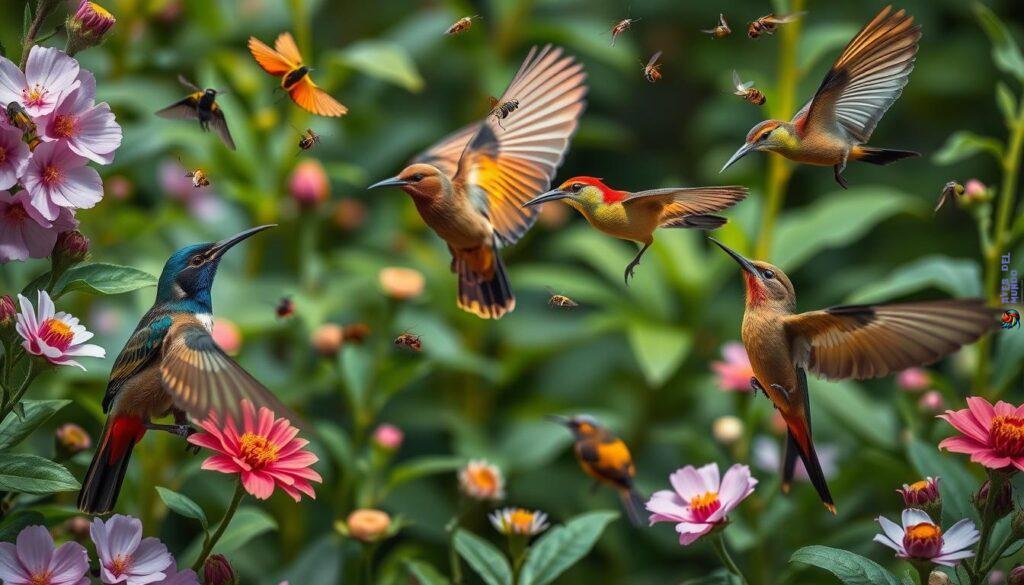
| Insectivorous Bird Species | Unique Adaptations | Ecological Significance |
|---|---|---|
| Ruby-throated Hummingbird | Ability to consume up to 2,000 small insects and spiders per day | Plays a vital role in controlling insect populations, particularly mosquitoes |
| Common Nighthawk | Can catch and consume up to 2,000 mosquitoes in a single night | Effective natural pest controller, helping to reduce the spread of mosquito-borne diseases |
| Blackburnian Warbler | Uniquely shaped bill allows it to efficiently extract insects from the innermost parts of coniferous trees | Plays a crucial role in maintaining the health of coniferous forest ecosystems during its breeding season |
Observing and Identifying Insectivorous Birds
Watching insectivorous birds in their natural habitats is rewarding. Birders and nature lovers can learn to spot these birds by using field guides and online resources. Joining bird monitoring programs helps us understand and protect these birds.
Field Guides and Resources
Field guides are key for spotting and identifying insectivorous birds. They have detailed pictures, descriptions, and info on their habits. Some top guides include:
- The Sibley Guide to Birds
- National Geographic Field Guide to the Birds of North America
- Birds of South America
- RSPB Handbook of British Birds
Online resources and apps are also great for learning about insectivorous birds. Sites like eBird, Audubon, and BirdLife International offer lots of info and ways to help with bird research. These tools help deepen your love for these birds.
| Resource | Description |
|---|---|
| eBird | A global database of bird observations that allows you to track your sightings and contribute to scientific research. |
| Audubon | A leading organization for bird conservation and education, providing a wealth of information and resources for bird enthusiasts. |
| BirdLife International | A global partnership of conservation organizations dedicated to the protection of birds and their habitats worldwide. |

By using these guides and online tools, you can get better at spotting insectivorous birds. This helps in their conservation and our understanding of these vital birds.
The Role of Citizen Science
Citizen science is key in learning more about insectivorous birds. It involves the public in tracking, reporting, and collecting data. This way, both amateurs and experts work together to understand insect-eating avian species better.
Through citizen science, people help protect insectivorous birds. These birds are important for controlling pests in our ecosystems.
The Indian Roller Count event is a great example. It happens from October 3 to October 12, 2024, in four Indian states. The Indian Roller is the state bird of Karnataka, Telangana, and Odisha.
People are asked to watch and count these insectivorous birds for 10 days. They can use the eBird Mobile App for this. It’s important to upload lists on eBird, even if no Indian Rollers are seen.
By joining the Indian Roller Count, the public helps in conservation. Insectivorous birds are crucial for keeping ecosystems balanced. Their insect-eating habits are vital.
This community involvement is essential for protecting these important species. It helps us understand and safeguard them.
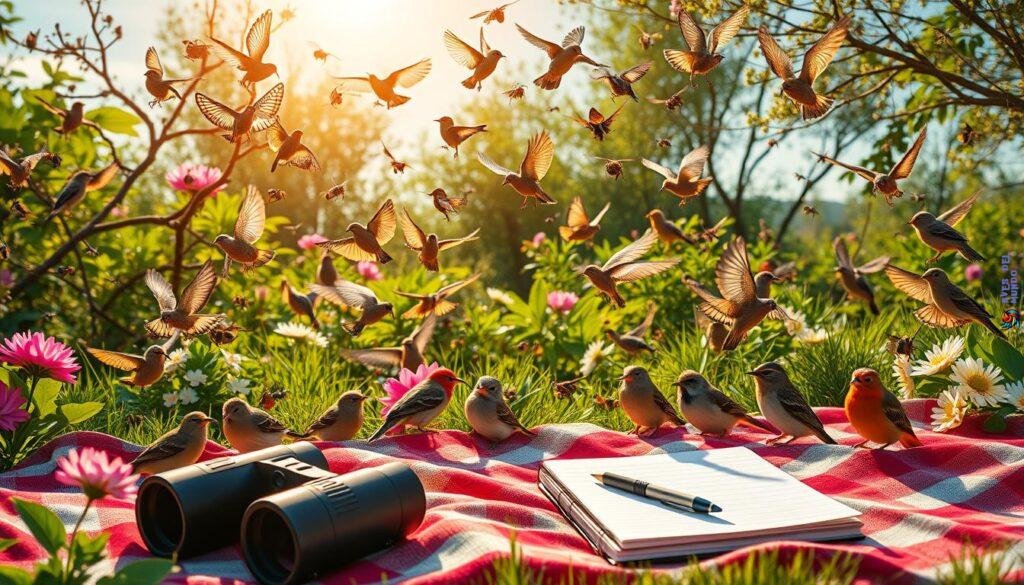
Citizen science lets people join the scientific process. They help in the conservation of insectivorous birds. These birds are vital for healthy ecosystems.
By working together, we can learn more about these amazing birds. This way, we ensure they stay in our natural world.
Insectivorous Birds in Folklore and Culture
Insectivorous birds play a big role in our culture, beyond just controlling pests. They are part of many stories, myths, and traditions worldwide. These birds are seen as wise and symbolize nature’s balance, inspiring people everywhere.
Insect-eating birds in folklore and mythology are often admired for their sharp senses and world navigation skills. They are seen as messengers or guides, linking the physical and spiritual worlds. For example, swallows symbolize rebirth in many cultures, while woodpeckers stand for strength and truth.
The role of insectivorous avians in human traditions is fascinating. In some places, their presence shows the ecosystem’s health. They also inspire art, literature, and even food, showing our deep connection with them.
Learning about the cultural significance of insectivorous birds helps us understand their importance. It shows how these birds and humans are connected. This knowledge helps us appreciate life’s complexity and the need to protect these birds and their homes.
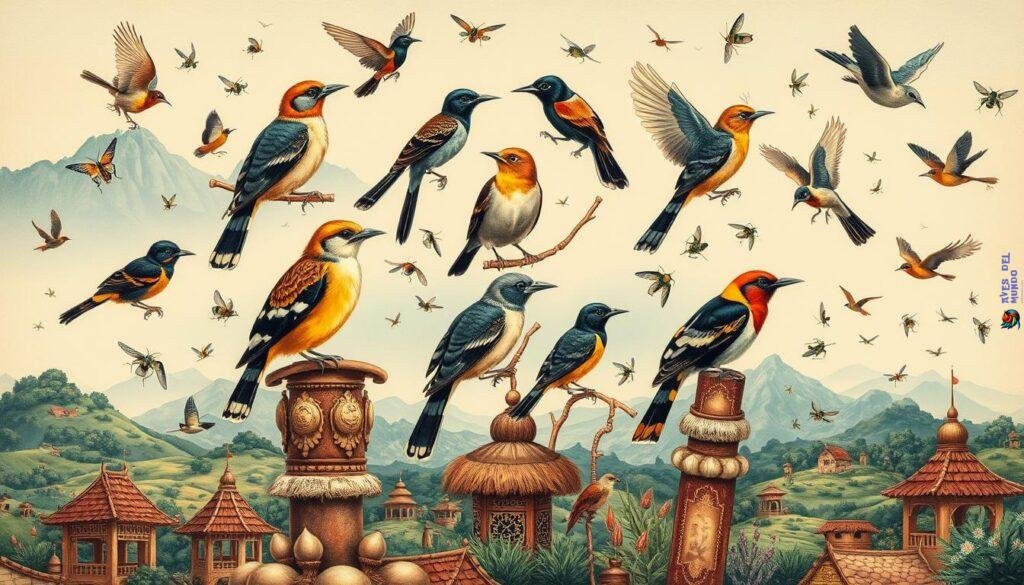
Future Research and Discoveries
The study of insectivorous birds is always growing. Scientists are exploring new areas in bird biology, ecology, and conservation. They aim to learn more about these insect-eating avians and their role in our ecosystems.
Every new finding makes us more amazed by these birds. We learn about their hunting skills and how they adapt to changes. This research helps us understand their importance in keeping our ecosystems balanced.
Our interest in these birds keeps growing as we learn more about them. Researchers are always finding new things. This will lead to better ways to protect these birds and help us appreciate them more.
The study of insectivorous birds is constantly changing. There are many exciting areas to explore. As we learn more, we’ll discover new things that will help us protect our planet.



